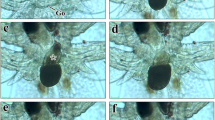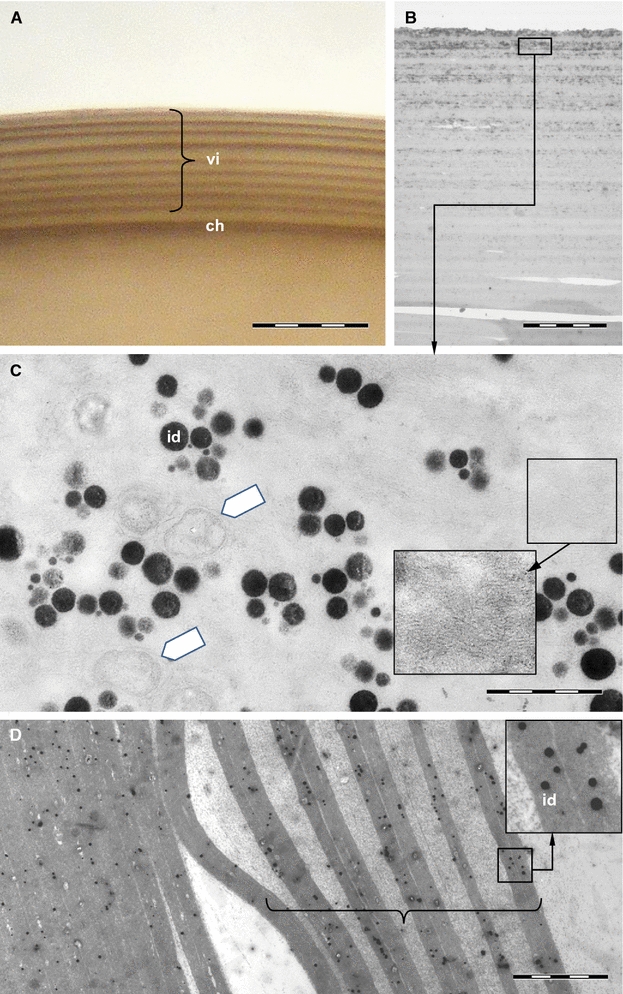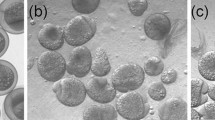Abstract
Fertilized goldfish eggs were dechorionated with a pair of forceps and were cut off along or a little above the equator into animal and vegetative parts at desired stages with a glass needle or ligated into two connected fragments before cleavage with baby hair loop. Some of the ligated eggs were detached by further fastening soon after ligation, and some released later at different stages (2-cell, 16-cell, 128-cell, 512-cell, mid-blastula) to let the organ-forming substance (OFS) enter the blastoderm. The cholinesterase (ChE) in the resulting embryos was assayed. The results are as follows. 1. All the 142 embryos developed from the animal hemispheres cut off or ligated off before cleavage gave rise to hyperblastula in which no ChE activity was observed. 2. All 50 embryos obtained from animal halves isolated at the 8-cell stage produced ChE. 3. Embryos developed from the eggs released before the 512-cell stage formed ChE, but the later the releasing of the hair knots, the smaller the number of ChE-producing embryos. 4. After the 512-cell stage (excluding this stage), neither ChE nor tissue differentiation occurred in the embryos developed from the unfastened eggs though their OFS flow was set free. Since ChE is thought to be a muscle-specific enzyme in the early developmental stage, it is concluded that the OFS in goldfish egg appears to be indispensable for the establishment of the mesoderm.
Similar content being viewed by others
References
Deno, T. and N. Satoh, 1984. Studies on the cytoplasmic determinant for muscle cell differentiation in ascidian embryos: An attempt at transplantation of the myoplasm.Develop. Growth and Dirrer. 26: 43–48.
Durante, M., 1956. Cholinesterase in development ofCiona intestinalis.Experientia 12: 307–308.
Karnovsky, M. J. and L. Roots, 1964. A “direct-coloring” thiocholine method for cholinesterases.J. Histochem. Cytochem. 12: 219–221.
Meedel, T. H. and J. R. Whittaker, 1983. Development of translationally active mRNA for larval muscle acetylcholinesterase during ascidian embryogenesis.Proc. Natl. Acad. Sci. USA 80: 4761–4765.
Oppenheimer, J. M., 1936. The development of isolated blastomeres ofFundulus heteroclitus.J. Exp. Zool,72: 247–269.
Reverberi, G., 1971. Ascidians, In: Experimental Embryology of Marine and Fresh Water Invertebrates (G. Reverberi, ed.), American Elaevier, New York, pp. 507–550.
Reverberi, G. and G. Ortolani, 1962. Twin larvae from halves of the same egg in ascidians.Develop. Biol. 5: 84–100.
Satoh, N., 1979. On the clock mechanism determining the time of tissue-specific enzyme development during ascidian embryogenesis. I. Acetylcholinesterase development in cleavage-arrested embryos.J. Embryol. Exp. Morph. 54: 131–139.
Tung, T. C., C. Y. Lee, Y. F. Y. Tung and S. C. Wu, 1951. The development of constricted egg ofCarassius.Science Rec. 4: 291–294.
Tung, T. C., C. Y. Lee, Y. F. Y. Tung, 1951. Further studies on the developmental potencies ofCarassius eggs. Acta Experimentali-Biologica Sinica4: 107–125 (in Chinese)
Tung, T. C., 1955. Experiments on the developmental potencies of egg-fragments and isolated blastomeres ofFundulus heterochitus.Acta Experimentali-Biologica Sinica 4: 129–145 (in Chinese)
Tung, T. C., S. C. Wu and Y. F. Y. Tung, 1955. The development of the isolated fragments ofCarassius eggs centrifuged after fertilization.Acta Experimentali-Biologica Sinica 4: 365–378 (in Chinese)
Tung, T. C. and Y. F. Y. Tung, 1944. The development of egg-fragments, isolated blastomeres and fused eggs in goldfish.Proc. Zool. Soc. Lond. 144: 46–64.
Tung, T. C., C. Y. Chang and Y. F. Y. Tung, 1945. Experiments on the developmental potencies of blastoderm and fragments of teleosteam eggs separated latitudinally.Proc. Zool. Soc. Lond. 115: 175–188.
Tung, T. C., S. C. Wu, Y. F. Yek, K. S. Li and M. C. Hsu, 1977. Cell differentiation in ascidian studied by nuclear transplanation.Scientia Sinica 20: 222–233.
Whittaker, J. R., 1973. Segregation during ascidian embryogenesis of egg cytoplasmic information for tissue-specific enzyme development.Proc. Natl. Acad. Sci., USA 70: 2096–2100.
Whittaker, J. R., 1977. Segregation during cleavage of a factor determining endodermal alkaline phosphatase development in ascidian embryos.Dev. Biol. 55: 196–200.
Whittaker, J. R., 1979. Cytoplasmic determinants of tissue differentiation in the ascidian egg.In: Determinants of Spatial Organization (S. Subtelny and I. R. Konigsberg ed.), Academic Press, New York, pp. 29–51.
Whittaker, J. R., 1980. Acetylcholinesterase development in extra cells caused by changing the distribution of myoplasm in ascidian embryos.J. Embryol. Exp. Morph. 55: 343–354.
Whittaker, J. R., 1982. Muscle lineage cytoplasm can change the developmental expression in epidermal lineage cells of ascidian embryos.Dev. Biol. 93: 463–470.
Author information
Authors and Affiliations
Additional information
Contribution No. 1507 from the Institute of Oceanology, Academia Sinica
Rights and permissions
About this article
Cite this article
Shicui, Z., Shangqin, W. The reaction time of organ-forming substance in goldfish EGG and its relationship with mesodermal formation. Chin. J. Ocean. Limnol. 6, 283–289 (1988). https://doi.org/10.1007/BF02850452
Received:
Issue Date:
DOI: https://doi.org/10.1007/BF02850452




